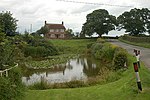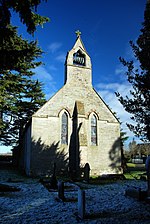Prees railway station
1858 establishments in EnglandDfT Category F2 stationsFormer London and North Western Railway stationsRailway request stops in Great BritainRailway stations in Great Britain opened in 1858 ... and 5 more
Railway stations in ShropshireRailway stations served by Transport for Wales RailShropshire building and structure stubsUse British English from December 2017West Midlands (region) railway station stubs

Prees railway station serves the village of Prees in Shropshire, England, although the station is a mile to the west of the village and in the parish of Wem Rural. The station is 18 miles 36 chains (29.7 km) from Crewe South Junction (approximately 14.0 mi (22.5 km) north of Shrewsbury) on the Welsh Marches Line. It was opened by the Crewe and Shrewsbury Railway in 1858. The station has two platforms and trains only stop here upon request. It is managed by Transport for Wales.
Excerpt from the Wikipedia article Prees railway station (License: CC BY-SA 3.0, Authors, Images).Prees railway station
Station Road,
Geographical coordinates (GPS) Address Nearby Places Show on map
Geographical coordinates (GPS)
| Latitude | Longitude |
|---|---|
| N 52.8992 ° | E -2.6895 ° |
Address
Station Road
Station Road
SY13 2DN , Wem Rural
England, United Kingdom
Open on Google Maps









